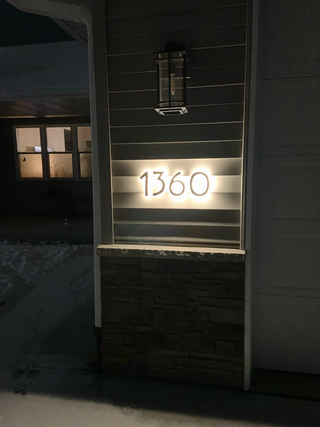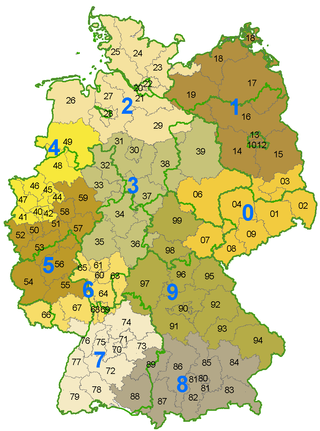
A postal code is a series of letters or digits or both, sometimes including spaces or punctuation, included in a postal address for the purpose of sorting mail.

A ZIP Code is a system of postal codes used by the United States Postal Service (USPS). The term ZIP was chosen to suggest that the mail travels more efficiently and quickly when senders use the code in the postal address.

Postal codes used in the United Kingdom, British Overseas Territories and Crown dependencies are known as postcodes. They are alphanumeric and were adopted nationally between 11 October 1959 and 1974, having been devised by the General Post Office. A full postcode is known as a "postcode unit" and designates an area with several addresses or a single major delivery point.

A Canadian postal code is a six-character string that forms part of a postal address in Canada. Like British, Irish and Dutch postcodes, Canada's postal codes are alphanumeric. They are in the format A1A 1A1, where A is a letter and 1 is a digit, with a space separating the third and fourth characters. As of October 2019, there were 876,445 postal codes using Forward Sortation Areas from A0A in Newfoundland to Y1A in Yukon.
Postal codes were introduced in France in 1964, when La Poste introduced automated sorting. They were updated to use the current 5 digit system in 1972.
Spanish postal codes were introduced on 1 July 1984, when the Sociedad Estatal de Correos y Telégrafos introduced automated mail sorting. They consist of five numerical digits, where the first two digits, ranging 01 to 52, correspond either to one of the 50 provinces of Spain or to one of the two autonomous cities on the African coast.

An address is a collection of information, presented in a mostly fixed format, used to give the location of a building, apartment, or other structure or a plot of land, generally using political boundaries and street names as references, along with other identifiers such as house or apartment numbers and organization name. Some addresses also contain special codes, such as a postal code, to make identification easier and aid in the routing of mail.
The Official Municipality Key, formerly also known as the Official Municipality Characteristic Number or Municipality Code Number, is a number sequence for the identification of politically independent municipalities or unincorporated areas. Other classifications for the identification of areas include postal codes, NUTS codes or FIPS codes.

Postal codes in the People's Republic of China are postal codes used by China Post for the delivery of letters and goods within mainland China.
A location identifier is a symbolic representation for the name and the location of an airport, navigation aid, or weather station, and is used for staffed air traffic control facilities in air traffic control, telecommunications, computer programming, weather reports, and related services.
Ukraine uses five-digit numeric postal codes that are written immediately to the right of the city or settlement name.
A Peruvian postal code is a five-digit string that comprises part of a postal address in Peru. Prior to 2011, only the major cities of Lima and Callao used postal codes. However, in February 2011 a nationwide system was implemented which employs a five-digit numeric format. Similar to the postal codes of Mexico, Brazil, Australia, the United States, and elsewhere, postal codes in Peru are strictly numerical, using only numbers.
For the purposes of directing mail, Sweden is divided into a number of postcode areas. The Swedish postcode system is administered by the Swedish Mail Service on behalf of the Swedish Post and Telecom Authority.

Código de Endereçamento Postal is the Brazilian postal code system commonly known as CEP. Introduced in 1972 as a sequence of five digits, it was expanded to eight digits in 1992 to allow for more precise localization. The standard format is "nnnnn-nnn".

Postal codes in Hungary are four digit numeric. The first digit is for the postal region, as listed below :

Germany introduced postal codes on 25 July 1941, in the form of a two-digit system that was applied initially for the parcel service and later for all mail deliveries. This system was replaced in 1962 in West Germany by a four-digit system; three years later East Germany followed with its own four-digit system. Whereas the Federal Republic introduced a system with space left for the East German postal system after a possible reunification, such as by omitting all codes starting with '1' and '9', the German Democratic Republic had a system that used all codes starting from '1' to '9' just for East Germany.
Postal codes in South Korea are composed of five digits. A new system of post codes was introduced on August 1, 2015. The first postal code in South Korea was established on July 1, 1970, and has been revised three times: in 1988, 2000, and 2015.

The Greek postal code system is administered by ELTA. Each city street or rural region has a unique five-digit number, its Ταχυδρομικός Κώδικας 'postal code' (ΤΚ). The first three digits identify the city, municipality or prefecture. In major cities, the final two digits identify streets or portions of streets.

In Poland, postal codes were introduced in 1973. They are five-digit codes of two-then-three digits, with a hyphen between them. The first digit indicates one of the 10 large postal regions the country is divided into. These areas do not follow the administrative divisions. The second and third digits specify a particular smaller region, and the last two are the number of a postal delivery branch.
Postal codes used in Saudi Arabia are colloquially known as postcodes.











